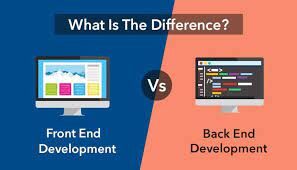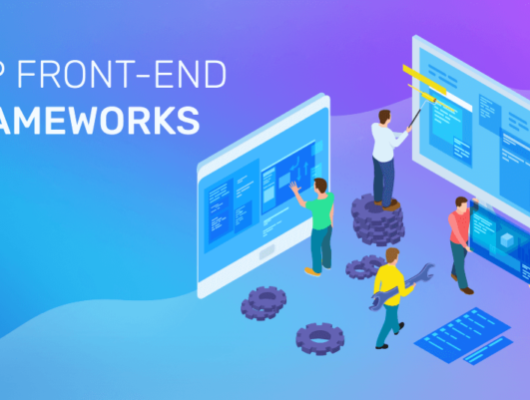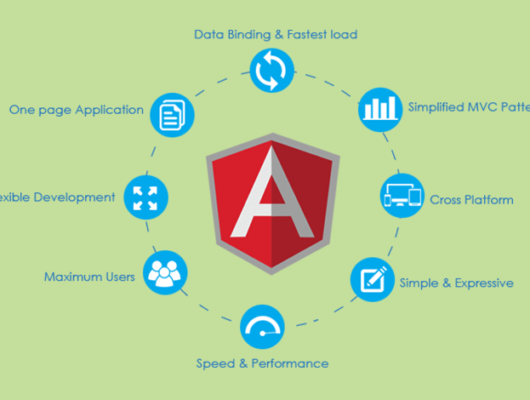- Front-End Development
- Back-End Development
- What’s the Difference?
- Full-Stack Development
- FAQ

Confused about the difference between front-end and back-end development?
Front-End Development :
Front-end development primarily deals with the user-facing side of a website or application. It involves designing and implementing the visual elements that users interact with, such as the layout, design, and responsiveness of the site. Front-end developers use languages like HTML, CSS, and JavaScript to create the structure, style, and interactivity of the website.
Back-End Development :
Back-end development, on the other hand, focuses on the behind-the-scenes functionality of a website. It involves managing databases, server configurations, and ensuring that the website operates smoothly. Back-end developers work with languages like Python, Ruby, PHP, Java, or databases like SQL to build the logic and infrastructure that supports the front-end.
Full-Stack Development :
While both front-end and back-end development are crucial for a website to work seamlessly, they require different skill sets. Front-end developers need expertise in design principles, user experience, and various front-end technologies. Back-end developers require skills related to server-side programming, database management, and system architecture.
Regarding salaries, the difference can vary based on several factors like location, experience, and demand. Historically, back-end developers might have commanded higher salaries due to the complexity and specialized nature of their work, but the demand for skilled front-end developers has increased significantly with the rise of interactive web applications.
Full-stack developers are proficient in both front-end and back-end development. They possess a broad skill set and can handle all aspects of web development, from designing user interfaces to managing server configurations and databases.
In summary, front-end and back-end development complement each other to create a fully functional website or application. Each role demands distinct skills and expertise, but the increasing overlap in technologies has led to the emergence of full-stack developers who are adept at both.

Front-End Development :
That’s a comprehensive overview of front-end development! You’ve touched on the essential programming languages, tools, and skills involved in creating the user-facing side of websites. Front-end development indeed demands a blend of technical proficiency and creative flair to craft engaging and functional user interfaces.
HTML serves as the backbone, structuring the content, while CSS enhances its visual presentation. JavaScript adds interactivity and advanced features, contributing significantly to the user experience. It’s true that knowledge of additional languages like Python, PHP, or Ruby can supplement a front-end developer’s toolkit, especially when collaborating with back-end developers.
Frameworks like jQuery, Bootstrap, and others expedite development by providing pre-built components and ensuring responsiveness across various devices. Libraries streamline coding processes, enhancing efficiency.
Moreover, the combination of design programs like Photoshop or Sketch with code editing tools helps front-end developers bring their designs to life while working seamlessly with designers, back-end developers, and user experience analysts to ensure a cohesive and user-friendly final product.
Regarding education, while a bachelor’s degree in relevant fields can provide a strong foundation, the field of web development often welcomes self-taught individuals who’ve gained expertise through coding bootcamps, projects, or practical experience. The emphasis is more on practical skills and a strong portfolio demonstrating the ability to create functional and visually appealing websites.
Front-end development continues to evolve with new technologies, tools, and design trends, making it an exciting and dynamic field within the broader spectrum of web development.
Front-End Developer Skills :
HTML : HTML is the standard programming language for implementing a webpage’s general content and structure.
CSS : Front-end developers use CSS to create a webpage’s colors, style, layout, and fonts. These devs may use CSS preprocessors like SASS or LESS to speed up the development process.
JavaScript : Front-end developers use JavaScript for sites that use interactive features like videos, audio, animations, and games. JavaScript includes libraries with extensions and plugins to run faster on websites.
Communication Skills : Effective communication skills help front-end developers work effectively with clients and back-end developers on web projects. Developers may need to explain design issues to clients who may not have technical backgrounds.
Creativity : Creative front-end developers improve the look, feel, and usability of websites. They help to ensure that a site is visually pleasing and easy to navigate beyond functionality alone.
Back-End Development :
It’s the backbone of a website, handling the server-side operations that empower the functionality and data management essential for the user-facing front end to operate smoothly.
Back-end developers indeed work on the technical aspects that users don’t directly see, dealing with servers, databases, and APIs that power the website’s functionality. Mastery of server-side programming languages like Java, Python, and Ruby is crucial for building the logic and operations that support the front end. Bootcamps and specialized training programs can be invaluable for learning these languages and enhancing skills.
Tools like SQL Server and Oracle play a fundamental role in storing, organizing, and manipulating data, while expertise in PHP frameworks, version control systems, and debugging tools ensures efficient back-end development. Collaboration with front-end developers, management, and stakeholders is key to aligning technical functionalities with project goals and user requirements.
Employers often look for candidates with bachelor’s degrees in computer science, programming, or web development for back-end positions. However, the industry also values practical experience and skills acquired through bootcamps or relevant work experiences, allowing individuals to enter this field without a traditional four-year degree.
For those aspiring to advance their careers, additional training, education, or certifications can open pathways to roles like software engineers, which often come with higher pay scales and greater responsibilities within software development teams.
The skills and expertise of back-end developers are pivotal in ensuring the robustness, security, and efficiency of websites and applications, forming a crucial part of the larger web development landscape.
Back-End Developer Skills :
Python : Back-end devs use the Python programming language to write data structures and algorithms to create websites. They also use Python libraries and frameworks, like Flask, Django, and NumPy.
Java : Developers on the back end use this programming language, created for compatibility with other platforms, to build applications.RubyRuby is a free, open-source, back-end programming language. Back-end devs can use it to quickly create new applications.
Ruby : includes everything a site needs to run, so full-stack developers also often use the language. Ruby works especially well for high-traffic websites.
Problem-Solving Skills : Back-end development often requires problem-solving skills to fix technical problems in the website creation process. These tasks may include debugging and testing back-end systems and applications.
Communication Skills : Back-end developers need strong communication skills to complete projects effectively. Developers may need to explain technical web design issues to stakeholders that may not have tech knowledge.
Front-End vs. Back-End Developers :
Here’s a simplified comparison table highlighting the key differences between front-end and back-end development:
| Aspect | Front-end Development | Back-end Development |
|---|---|---|
| Focus | User-facing side of the website/application | Behind-the-scenes functionality and server operations |
| Responsibilities | Designing visual elements, UI/UX, client-side scripting | Managing databases, server configurations, server-side logic |
| Languages | HTML, CSS, JavaScript, frameworks like React, Angular | Python, Ruby, PHP, Java, databases like SQL |
| Skills Required | Design principles, user experience, front-end frameworks | Server-side programming, database management, system architecture |
| Interaction | Directly interacts with users | Interacts with databases, servers, and internal systems |
| Salaries | Varied, depending on experience and demand | Historically higher due to complexity and specialization |
| What They Do | Front-end developers focus on designing the physical appearance of websites with front-end programming languages. The visual aspect of a website is the result of front-end development — including fonts, colors, layout, and graphics. | Back-end developers create the structure or logic of a website by using server-side programming languages. They write code that tells the website how to bring the front-end programming languages alive. |
| Average Salary | front-end developers earn $101,876 per year | Back-end developers earn an average of $115,437 per year |
| Who They Work With | Front-end developers, management, business stakeholders | Back-end developers, clients, management, business stakeholders |
This table provides a snapshot of the distinct aspects of front-end and back-end development, showcasing their respective focuses, responsibilities, key languages, required skills, interactions, and historical salary differences.
Full-Stack Development :
Full-stack development indeed covers both front-end and back-end aspects of an application, allowing developers to oversee and contribute to the entire development process. Their versatility in understanding both sides of development makes them valuable for companies seeking comprehensive skill sets.
These developers possess proficiency in various programming languages such as JavaScript, Java, Python, and CSS, enabling them to work across different layers of an application. Additionally, their skills often extend to web architecture, algorithm development, database management, and version control systems like Git and GitHub.
Becoming a full-stack developer typically requires a more extended period due to the need for mastery in both front-end and back-end skills. However, this broader skill set can lead to increased job opportunities and a competitive edge in the industry.
full-stack developers earned an average annual salary of $81,902. This compensation reflects the demand for their diverse skill set and ability to handle various aspects of application development.
FAQS :
Questions About Types of Developers :
Is front-end development easy?
Front-end development certainly has its challenges, but whether it’s easy or difficult can vary from person to person. It involves a mix of coding languages like HTML, CSS, and JavaScript, along with frameworks and libraries, and requires an understanding of design principles and user experience. Some find it easier due to the immediate visual feedback, while others may struggle with the complexities of different browsers, responsive design, and managing user interactions. Overall, it demands dedication and a willingness to learn and adapt to new technologies.
What is needed for front-end development?
Front-end development requires proficiency in HTML, CSS, and JavaScript as the core languages for building the structure, style, and interactivity of web pages. Additionally, knowledge of frameworks and libraries like React, Angular, Vue.js, and Bootstrap can significantly streamline development and enhance functionality.
Creativity is vital for crafting engaging user interfaces, and effective communication skills help collaborate with designers and back-end developers to bring designs and functionalities to life. Staying updated with the latest trends, tools, and technologies is crucial in this fast-evolving field.
What does a back-end developer do?
Back-end developers focus on server-side programming, managing databases, server configurations, and building the logic and functionality that powers a website or application. They work with languages like Python, Ruby, PHP, Java, or Node.js to handle data processing, user authentication, server security, and interactions with the front-end. Their role is crucial in ensuring that the application or website functions correctly, securely, and efficiently.
How do I become a back-end developer?
A bachelor’s degree in fields like computer science, software engineering, or information technology can provide a solid foundation. However, it’s not the only path. Many successful back-end developers have gained expertise through self-study, online courses, coding bootcamps, or practical experience.
Learning programming languages such as Python, Java, Ruby, PHP, or Node.js is essential. Understanding databases (SQL or NoSQL), server-side frameworks, version control systems like Git, and cloud computing concepts is also beneficial.
Building projects, contributing to open-source projects, and creating a portfolio showcasing your skills can also significantly boost your chances of breaking into the field, even without a traditional degree. Continuously learning and staying updated with the latest trends and technologies is crucial in this rapidly evolving domain.
we can make your any type of website in short period of time.







